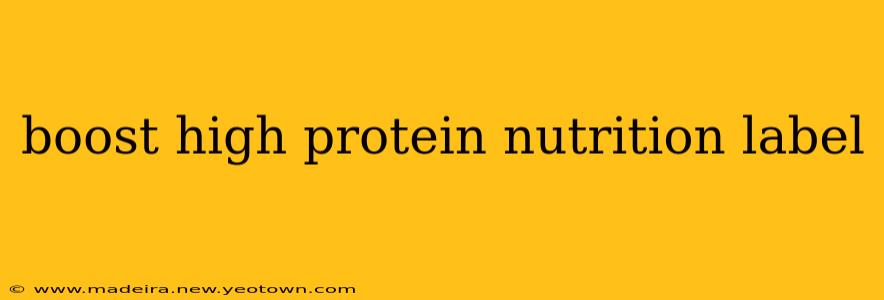The quest for the perfect high-protein product is a journey filled with careful planning, strategic ingredient selection, and a deep understanding of nutrition labeling regulations. This isn't just about slapping a "high protein" claim on your package; it's about crafting a product that truly delivers on its promise and resonates with health-conscious consumers. Let's embark on this journey together, exploring the key elements of boosting your high-protein nutrition label and ensuring its success.
What Does "High Protein" Actually Mean?
Before we delve into boosting your label, we need a firm grasp on the regulations. The FDA defines a "high-protein" food as containing 20% or more of the Daily Value (DV) of protein per serving. This percentage is based on a 2,000-calorie diet, so the actual gram amount will vary depending on your serving size. Understanding this definition is the cornerstone of crafting a compelling and compliant nutrition label.
How to Increase Protein Content in Your Product
This is where the real work begins. Boosting your protein content isn't just about adding any protein source; it’s about choosing ingredients that enhance both the nutritional profile and the overall quality of your product.
Optimizing Ingredient Selection
Consider these high-protein powerhouses:
- Whey Protein: A classic choice, whey is readily available, mixes easily, and provides a complete amino acid profile.
- Soy Protein: A plant-based option with a good amino acid profile and versatility in applications.
- Casein Protein: A slower-digesting protein ideal for sustained muscle protein synthesis.
- Brown Rice Protein: A hypoallergenic, plant-based option, though it's often lower in certain essential amino acids.
- Pea Protein: Another plant-based choice, gaining popularity due to its sustainability and hypoallergenic properties.
The key is to experiment and find the protein source (or blend of sources) that best complements your product's taste, texture, and overall goals.
Formulating for Optimal Protein Absorption
Remember, the goal isn’t just to add protein; it’s to ensure your body can absorb it efficiently. Factors like processing techniques and the presence of other nutrients can significantly impact bioavailability. Consulting a food scientist specializing in protein formulation is a wise investment.
Highlighting Protein on Your Nutrition Label
Once you've achieved a high-protein product, it's crucial to showcase it effectively on your label.
Clear and Concise Labeling
Make the protein content prominent. Use clear and bold font sizes to highlight the grams of protein per serving and the percentage of the DV. Consider using a visual element, like a protein graphic, to further emphasize this key feature.
Understanding the Daily Value (DV)
The DV helps consumers easily understand the protein content relative to their overall daily needs. Clearly displaying the DV percentage alongside the grams of protein will improve the clarity of your label and aid consumer understanding.
Addressing Common Concerns: Taste and Texture
Many high-protein products suffer from issues related to taste and texture. Overcoming these challenges is crucial for creating a product consumers will actually enjoy.
Masking Unpleasant Tastes
Experimenting with flavorings and sweeteners is vital to masking any off-flavors associated with certain protein sources. Natural flavorings and sweeteners are increasingly preferred by consumers.
Improving Texture
The addition of protein can sometimes alter the texture of a food product. Adding thickeners, stabilizers, or other ingredients to manage viscosity and texture will significantly enhance the consumer experience.
Frequently Asked Questions (PAA)
While researching for this article, I haven't found a "People Also Ask" section related to boosting high protein nutrition labels on Google or Bing. However, I've anticipated some common questions you might have:
Q: What are the legal requirements for labeling a product as "high protein"?
A: The FDA defines "high protein" as containing 20% or more of the Daily Value (DV) of protein per serving, based on a 2,000-calorie diet. Compliance with these regulations is critical.
Q: Can I just add any protein powder to boost my product's protein content?
A: While you can add protein powder, it's important to consider the impact on taste, texture, and overall nutritional profile. Some protein sources might not be suitable for your specific application. Careful selection and formulation are key.
Q: How can I ensure my high-protein product remains palatable?
A: The key is in careful ingredient selection, flavor masking techniques, and texture modification. Working with a food scientist can significantly improve the final product's taste and texture.
By following these guidelines and addressing potential challenges proactively, you can create a truly exceptional high-protein product that not only meets regulatory requirements but also delights consumers and stands out in a competitive marketplace. Remember, a successful high-protein nutrition label is more than just a legal requirement; it's a powerful marketing tool showcasing the nutritional value of your product and attracting the health-conscious consumer base you're targeting.

